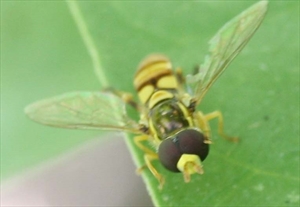Hoverflies. They are known as syrphid flies or flower flies, and belong to the family Syrphidae.
Pacific Pests, Pathogens and Weeds - Online edition
Pacific Pests, Pathogens & Weeds
Hoverflies (084)
There are many kinds of hoverflies in Pacific island countries. Ischiodon scutellaris is given as an example. In Oceania, it has been recorded in Fiji, Guam, and Solomon Islands.
Worldwide.
Aphids
Eggs are oval and white. They are laid singly near colonies of aphids, or even among them. They are easily seen with the eye. The legless larva (or maggot) is pale green at first becoming darker, and has short soft spines on the sides (Photo 1). The body narrows towards the head, where the mouth is used to catch and hold aphids before sucking them dry. As the larva grows it moults, i.e., it changes its skin. When fully grown, it is up to 10 mm long. At that time, it attaches itself to the underside of a leaf and swells up and hardens into a smooth, teardrop-shaped puparium (not a pupa - the real pupa is inside the smooth outer skin of the last maggot stage). It is up to 7 mm long. After a few days, depending on the temperature, the adult hatches, finds flowers with nectar to feed on, and then mates.
The adults are typical flies with one pair of wings, large eyes and yellow and black-banded abdomens (Photo 2). They are often seen hovering above flowering plants and sitting on flowers, sucking up nectar.
Hoverflies do not damage crops: they are not pests. They are beneficial, occurring on many crops. They are important biological control agents. The larvae feed on aphids (Photo 2), which are their main food, but probably they also eat caterpillars, mealybugs and even other hoverfly larvae.
Look for the slug-like larvae feeding among colonies of aphids. Their narrow heads are often seen moving about as the larva searches for food. They are rarely seen in populations of aphids on crops with hairy leaves such as tomato and squash. Look for flies with yellow and black-banded bodies that hover over flowers, hovering and then suddenly moving forwards or sideways only to hover again.
The adults can easily be confused with wasps and bees. Hoverflies' bodies are slender with yellow-black wasp-like patterns and some have narrow waists. Hoverflies, however, lack a sting, have delicate legs, massive eyes, and a single pair of wings which are held out sideways at rest, whereas wasps fold their wings along their bodies when resting. Some types of hoverflies look like bees, but the maggots of these do not feed on aphids.
GENERAL
Hoverflies are very effective biological control agents, but only appear in the crop if there are aphids for them to eat. Note, pesticides easily kill hoverflies, and routine spray programs will destroy them completely.
Careful monitoring of the crop will help to determine whether the hoverflies are present and are controlling the aphids. If more than two hoverfly maggots are present in a colony of aphids, there is no need to do anything, as they will effectively control the aphids for you.
PROVIDING THEM WITH FOOD
Garden flowers and weeds provide hoverfly adults with sugar as nectar. Planting flowering plants in the field and around the edges of the gardens will encourage hoverflies to stay and to breed. Large open flowers, such as daisies, are particularly good sources of food, providing nectar for the adults.
DANGERS FROM USING PESTICIDES
Most pesticides are harmful to hoverflies, and they should only be used against aphids if hoverfly larvae are absent or in low numbers. Pyrethrum and synthetic pyrethroids should be avoided as they are particularly harmful to biological control agents. Preferably, use selective insecticides for the control of aphids, for example, pymetrozine or primicarb.
AUTHORS Suzanne Neave & Grahame Jackson
CABI (2019) Ischiodon scutellaris. Crop Protection Compendium. (https://www.cabi.org/cpc/datasheet/28920); and from Wei TJ (2019) Ischiodon scutellaris - Hover Fly. National University of Singapore. (https://wiki.nus.edu.sg/display/TAX/Ischiodon+scutellaris+-+Hover+Fly). Photos 1&2 Suzanne Neave, CABI, UK.
Produced with support from the Australian Centre for International Agricultural Research under project PC/2010/090: Strengthening integrated crop management research in the Pacific Islands in support of sustainable intensification of high-value crop production, implemented by the University of Queensland and the Secretariat of the Pacific Community.






